High Impact Tutoring Built By Math Experts
Personalized standards-aligned one-on-one math tutoring for schools and districts
In order to access this I need to be confident with:
Addition and subtraction Multiplication and division SubstitutionArithmetic sequence
Here you will learn what an arithmetic sequence is, how to continue an arithmetic sequence and how to generate an arithmetic sequence.
Students will first learn about arithmetic sequences as part of algebra in high school.
What are arithmetic sequences?
Arithmetic sequences (arithmetic progressions) are ordered sets of numbers that have a common difference (d) between each consecutive term.
If you add or subtract the same number each time to make the sequence, it is an arithmetic sequence.
For example,
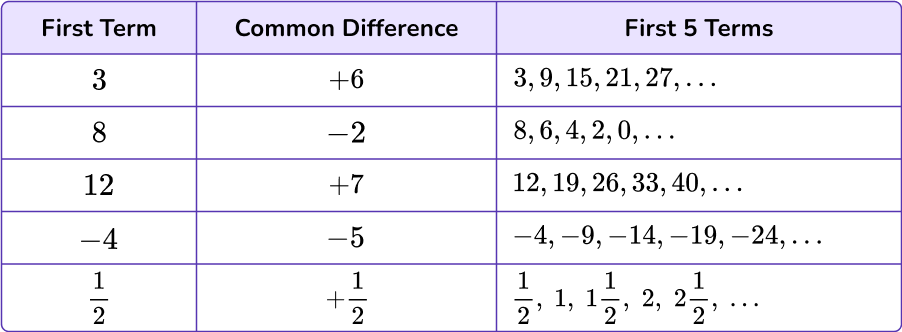
A recursive formula uses the previous number in the sequence to determine the successive number.
The arithmetic sequence recursive formula is:
a_{n+1}= a_n + dWhere,
a_{n} is the n th term (general term)
a_{n+1} is the term after n
n is the term position
d is the common difference
An arithmetic sequence uses the position of the n th term of a sequence to calculate the n th term.
The arithmetic sequence explicit formula is:
a_n=a_1+d(n-1)Where,
a_{n} is the n th term (general term)
a_{1} is the first term
n is the term position
d is the common difference
You create both arithmetic sequence formulas by looking at the following example:

You can see the common difference (d) is 6, so d=6.
The recursive formula is a_{n+1}=a_n+d, for a_1=3.
\begin{aligned} & a_2=a_1+6=3+6=9 \\\\ & a_3=a_2+6=9+6=15 \\\\ & a_4=a_3+6=15+6=21 \\\\ & a_5=a_4+6=21+6=27 \end{aligned}The explicit formula is a_n=a_1+d(n-1), for a_1=3.
\begin{aligned} & a_2=3+6(2-1)=3+6(1)=9 \\\\ & a_3=3+6(3-1)=3+6(2)=15 \\\\ & a_4=3+6(4-1)=3+6(3)=21 \\\\ & a_5=3+6(5-1)=3+6(4)=27 \end{aligned}What are arithmetic sequences?
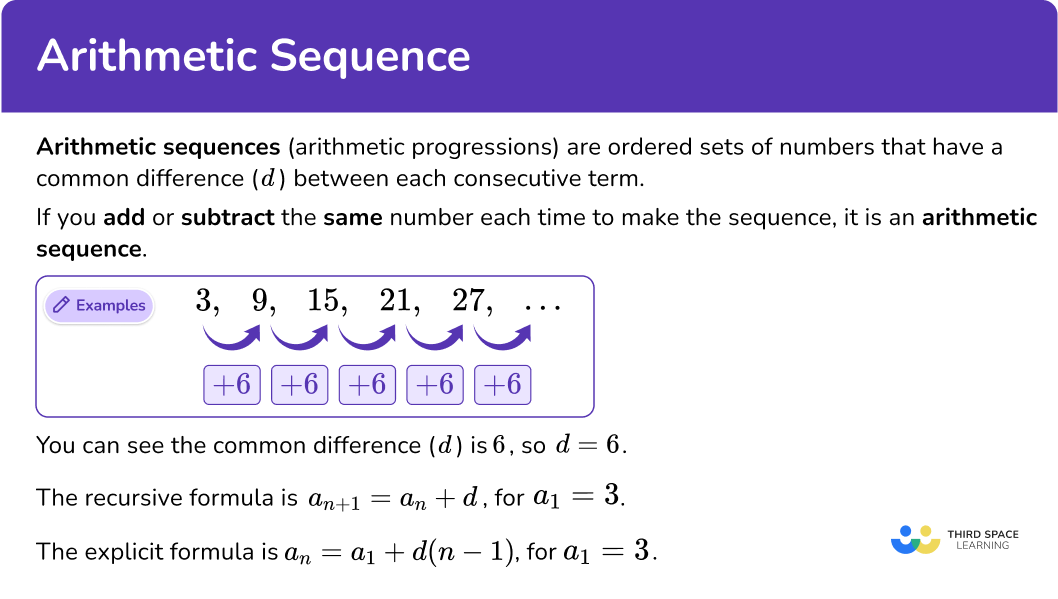
Common Core State Standards
How does this relate to high school math?
- Functions – Building Functions (HSF.BF.A.2)
Write arithmetic and geometric sequences both recursively and with an explicit formula, use them to model situations, and translate between the two forms.
- Functions – Linear, Quadratic and Exponential Models (HSF.LE.A.2)
Construct linear and exponential functions, including arithmetic and geometric sequences, given a graph, a description of a relationship, or two input-output pairs (include reading these from a table).
![[FREE] Arithmetic Sequence Formula Worksheet (Grade 9 to 12)](https://thirdspacelearning.com/wp-content/uploads/2024/05/Arithmetic-Sequence-Worksheet-listing-image.png)
[FREE] Arithmetic Sequence Formula Worksheet (Grade 9 to 12)
![[FREE] Arithmetic Sequence Formula Worksheet (Grade 9 to 12)](https://thirdspacelearning.com/wp-content/uploads/2024/05/Arithmetic-Sequence-Worksheet-listing-image.png)
Use this worksheet to check your grade 9 to 12 students’ understanding of arithmetic sequence formula. 15 questions with answers to identify areas of strength and support!
DOWNLOAD FREE![[FREE] Arithmetic Sequence Formula Worksheet (Grade 9 to 12)](https://thirdspacelearning.com/wp-content/uploads/2024/05/Arithmetic-Sequence-Worksheet-listing-image.png)
[FREE] Arithmetic Sequence Formula Worksheet (Grade 9 to 12)
![[FREE] Arithmetic Sequence Formula Worksheet (Grade 9 to 12)](https://thirdspacelearning.com/wp-content/uploads/2024/05/Arithmetic-Sequence-Worksheet-listing-image.png)
Use this worksheet to check your grade 9 to 12 students’ understanding of arithmetic sequence formula. 15 questions with answers to identify areas of strength and support!
DOWNLOAD FREEHow to continue an arithmetic sequence
In order to continue an arithmetic series:
- To identify \textbf{d}, take two consecutive terms from the sequence.
- Subtract the first term from the next term to find the common difference, \textbf{d}.
- Add the common difference to the last term in the sequence to find the next term.
- Repeat Step \bf{3} for each new term.
Arithmetic sequences examples
Example 1: continuing an arithmetic sequence given a graph
Calculate the next three terms for the arithmetic sequence shown in the graph below.
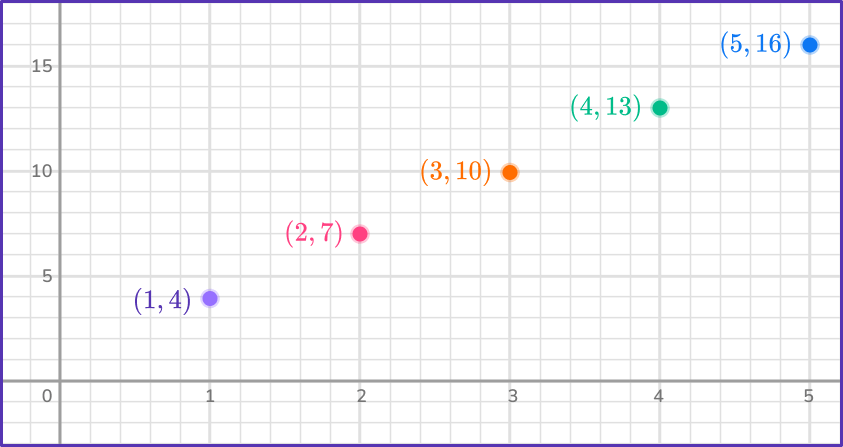
- To identify \textbf{d}, take two consecutive terms from the sequence.
There are 5 terms shown. Any two consecutive terms of a geometric sequence can be used. Let’s use the third term and the fourth term: (3,10) and (4,13).
The x coordinate is the term position (first, second, third, etc.). The y coordinate is the actual term value.
So (3,10) is a_3=10 and (4,13) is the a_4=13.
2Subtract the first term from the next term to find the common difference, \textbf{d}.
d=13-10=33Add the common difference to the last term in the sequence to find the next term.

4Repeat Step \bf{3} for each new term.
\begin{aligned} & 19+3=22 \\\\ & 22+3=25 \end{aligned}The next three terms in the sequence are 19, 22, and 25.
Example 2: continuing an arithmetic sequence with negative numbers in a table
Calculate the next three terms for the sequence in the table below.
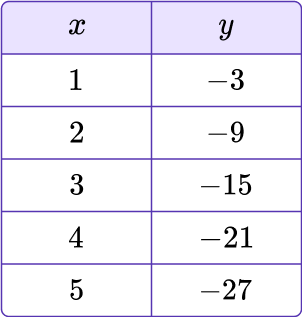
To identify \textbf{d}, take two consecutive terms from the sequence.
There are 5 terms shown. Any two consecutive terms of a geometric sequence can be used. Let’s use the third term and the fourth term: (3,–15) and (4,–21).
In the table, the x value is the term position (first, second, third, etc.). The y value is the actual term value.
Subtract the first term from the next term to find the common difference, \textbf{d}.
Add the common difference to the last term in the sequence to find the next term.
Repeat Step \bf{3} for each new term.
The next three terms are -33, -39, and -45.
How to find a formula for an arithmetic sequence
In order to find a formula for an arithmetic sequence:
- Identify the first term.
- Subtract the second term by the first term to find the common difference, \textbf{d}.
- Write the recursive formula, \bf{\textbf{a}}_{\textbf{n}+1}={\textbf{a}}_{\textbf{n}}+{\textbf{d}}.
- Write the explicit formula, \bf{\textbf{a}}_{\textbf{n}}={\textbf{a}}_1+{\textbf{d}}({\textbf{n}}-1).
Example 3: continuing an arithmetic sequence with decimals
Write the recursive and explicit formula for the sequence below.
0.1, \, 0.3, \, 0.5, \, 0.7, \, 0.9, …Identify the first term.
Subtract the second term by the first term to find the common difference, \textbf{d}.
Write the recursive formula, \bf{\textbf{a}}_{\textbf{n}_+1}={\textbf{a}}_{\textbf{n}}+{\textbf{d}}.
Replace d with 0.2 in the formula.
a_{n+1}=a_n+0.2
Write the explicit formula, \bf{\textbf{a}}_{\textbf{n}}={\textbf{a}}_1+{\textbf{d}}({\textbf{n}}-1).
Replace a_1 with 0.1 and d with 0.2 in the formula.
a_n=0.1+(0.2){n-1}
This can also be simplified to a_n=0.2n-0.1.
Example 4: writing formulas given a sequence with fractions
Write the recursive and explicit formula for the sequence below.
\cfrac{1}{2} \, , \, \cfrac{3}{4}\, , \, 1 \, , \, \cfrac{5}{4} \, , \, \cfrac{3}{2} \, , \ldotsIdentify the first term.
Subtract the second term by the first term to find the common difference, \textbf{d}.
Write the recursive formula, \bf{\textbf{a}}_{\textbf{n}_+1}={\textbf{a}}_{\textbf{n}}+{\textbf{d}}.
Replace d with \cfrac{1}{4} in the formula.
a_{n+1}=a_n+\cfrac{1}{4}
Write the explicit formula, \bf{\textbf{a}}_{\textbf{n}}={\textbf{a}}_1+{\textbf{d}}({\textbf{n}}-1).
Replace a_1 with \cfrac{1}{2} and d with \cfrac{1}{4} in the formula.
a_n=\cfrac{1}{2}+\cfrac{1}{4} \, (n-1)
This can also be simplified to a_n=\cfrac{1}{4} \, n+\cfrac{1}{4}.
How to translate between recursive and explicit formulas
In order to translate between recursive and explicit formulas:
- Identify the common difference, \textbf{d} and first term, \bf{\textbf{a}_1}.
- Rewrite the formula.
Example 5: translate between recursive and explicit
The recursive formula for an arithmetic sequence is a_{n+1}=a_n-2.5 and a_1=3.1.
Identify the common difference, \textbf{d} and first term, \bf{\textbf{a}_1}.
d is the constant in the recursive formula, so d=-2.5 and a_1=3.1.
Rewrite the formula.
The explicit formula of an arithmetic sequence is a_n=a_1+d(n-1).
The explicit formula for this sequence is a_n=3.1+[-2.5(n-1)].
This can also be simplified to a_n=-2.5 n+5.6.
Example 6: translate between explicit and recursive
The explicit formula for an arithmetic sequence is a_n=2,000+4.5(n-1).
Identify the common difference, \textbf{d} and first term, \bf{\textbf{a}_1}.
a_1 is the constant in the explicit formula, so a_1=2,000.
d is the coefficient in the explicit formula, so d=4.5.
Rewrite the formula.
The recursive formula of an arithmetic sequence is a_{n+1}=a_n+d.
The recursive formula for this sequence is a_{n+1}=a_n+4.5 and a_1=2,000.
Note: Always define a_1 with the recursive formula.
Teaching tips for arithmetic sequence
- Look for worksheets and activities that allow students to explore the graphs and tables of arithmetic sequences to compare and contrast how different values for the first term and common difference d change the sequence.
Easy mistakes to make
- Multiplying the value for a term to get another term of an arithmetic sequence
The relationship from term to term in an arithmetic sequence is always additive, not multiplicative. For this reason, always look for the common difference of an arithmetic sequence, instead of using multiplication.
For example,
Sequence A: 2, 4, 6, 8, 10
Although 2 \times 2=4, this does not work for the rest of the terms.
Since this sequence is arithmetic, the rule from term to term is +2. Always check all terms before deciding the rule.
- Thinking arithmetic sequences with negative terms always decrease
If the common difference is negative, this is true. But not necessarily if the terms are negative.
For example,
Sequence B: -48, -40, -32, -24, -16
This sequence has a constant difference of +8. This means that even though the sequence is showing negative integers rather than positive integers, it is still increasing.
- Confusing sequence notation
Since sequence notation looks similar to other types of mathematical notation, such as exponential notation, it can be easy to confuse them. The first term of the sequence should always be defined, and is often a_1.
If a_1 is the first term, the successive terms of the geometric sequence follow this same pattern. Such as the fifth term, which is a_5. This is NOT the same as a^{5}, which is a to the power of 5, an exponent.
For example,
a_n is the n th term, a_{n+1} is the next term, and a_{n-1} is the preceding term.
- Confusing the previous term with the next term
The notation for the previous term is a_{n-1} and the notation for the next term is a_{n+1}. Pay attention to whether the 1 is being added or subtracted to decide which term the notation is referring to.
Related number patterns lessons
Arithmetic sequences practice questions
1) Calculate the next three terms for the sequence in the graph below.





In the graph, the x coordinate is the term position (first, second, third, etc.). The y coordinate is the actual term value.
There are 4 terms shown. Any two consecutive terms of a geometric sequence can be used to find the common difference. Let’s use the first term and the second term: (1,0.22) and (2,0.32).
The common difference:
d = 0.32-0.22 = 0.1
Use the common difference to calculate the next three terms.
0.52+0.1=0.62
0.62+0.1=0.72
0.72+0.1=0.82
2) Calculate the next three terms for the given sequence below.
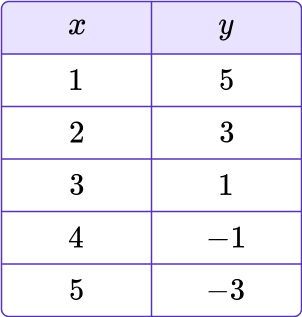




In the table, the x value is the term position (first, second, third, etc.). The y value is the actual term value.
There are 5 terms shown. Any two consecutive terms of a geometric sequence can be used to find the common ratio. Let’s use the first term and the second term: (1,5) and (2,3).
The common difference:
d = 3-5 = -2
Use the common difference to calculate the next three terms.
-3+(-2)=-5
-5+(-2)=-7
-7+(-2)=-9
3) What is the recursive formula for the sequence -37, -31, -25, -19, -13, …?

a_{n+1}=a_n-6 and a_1=-37


a_{n+1}=a_n+6 and a_1=-37

Identify the first term.
a_1=-37
The common difference:
d=-31-(-37) = 6
Write the recursive formula, a_{n+1}=a_n+d.
Replace d with 6 in the formula.
a_{n+1}=a_n+6
4) What is the explicit formula for the sequence \cfrac{3}{4} \, , \, \cfrac{5}{4} \, , \, \cfrac{7}{4} \, , \, \cfrac{9}{4} \, , \, \cfrac{11}{4}, \ldots?

a_{n+1}=\cfrac{3}{4}+\cfrac{2}{4} \,(n-1) and a_1=\cfrac{3}{4}



Identify the first term.
a_1=\cfrac{3}{4}
The common difference:
\begin{aligned} & d=\cfrac{5}{4}-\cfrac{3}{4} \\\\ & d=\cfrac{2}{4} \end{aligned}
Write the explicit formula, a_n=a_1+d(n-1).
Replace a_1 with \cfrac{3}{4} and d with \cfrac{2}{4} in the formula.
a_n=\cfrac{3}{4}+\cfrac{2}{4} \, (n-1)
This can also be simplified to a_n=\cfrac{2}{4} \, n+\cfrac{1}{4}.
5) The recursive formula for an arithmetic sequence is a_{n+1}=a_n-0.05 and a_1=-1. What is the explicit formula?




d is the coefficient in the recursive formula, so d=-0.05 and a_1=-1.
The explicit formula of an arithmetic sequence is a_n=a_1+d(n-1).
The explicit formula for this sequence is a_n=-1+[-0.05(n-1)].
This can also be simplified to a_n=-0.05 n-0.95.
6) The explicit formula for an arithmetic sequence is a_n=3.4+2(n-1). What answer choice does NOT represent the sequence?


First five terms: 3.4, 5.4, 7.4, 9.4, 11.4

a_{n+1}=a_n+2 and a_1=3.4

Use the distributive property to simplify.
\begin{aligned} & a_n=3.4+2(n-1) \\\\ & a_n=3.4+2 n-2 \\\\ & a_n=2 n+3.4-2 \\\\ & a_n=2 n+1.4 \end{aligned}
AND
The first five terms:
\begin{aligned} & a_1=3.4+2(1-1)=3.4+2(0)=3.4 \\\\ & a_2=3.4+2(2-1)=3.4+2(1)=5.4 \\\\ & a_3=3.4+2(3-1)=3.4+2(2)=7.4 \\\\ & a_4=3.4+2(4-1)=3.4+2(3)=9.4 \\\\ & a_5=3.4+2(5-1)=3.4+2(4)=11.4 \end{aligned}
AND
a_1 is the coefficient in the explicit formula, so a_1=3.4.
d is the coefficient in the explicit formula, so d=2.
The recursive formula of an arithmetic sequence is a_{n+1}=a_n+d.
The recursive formula for this sequence is a_{n+1}=a_n+2 and a_1=3.4.
Arithmetic sequence FAQs
Unless defined otherwise, a sequence can extend infinitely, meaning the list of numbers (or terms) never stops, so there is no last number in the sequence.
The recursive formula requires the term before it to calculate the next term. The explicit formula uses the term position (n th term of an arithmetic sequence ) to calculate the term value.
The next lessons are
Still stuck?
At Third Space Learning, we specialize in helping teachers and school leaders to provide personalized math support for more of their students through high-quality, online one-on-one math tutoring delivered by subject experts.
Each week, our tutors support thousands of students who are at risk of not meeting their grade-level expectations, and help accelerate their progress and boost their confidence.

Find out how we can help your students achieve success with our math tutoring programs.
[FREE] Common Core Practice Tests (3rd to 8th Grade)
Prepare for math tests in your state with these 3rd Grade to 8th Grade practice assessments for Common Core and state equivalents.
Get your 6 multiple choice practice tests with detailed answers to support test prep, created by US math teachers for US math teachers!